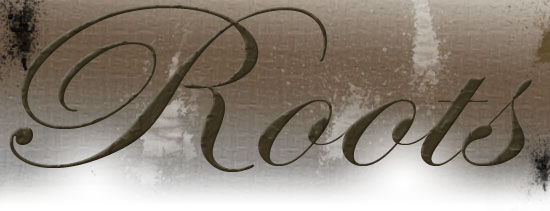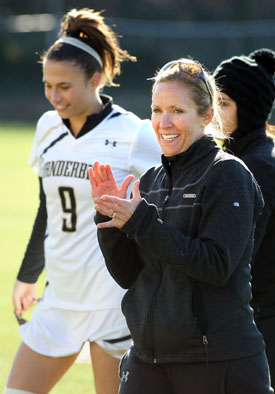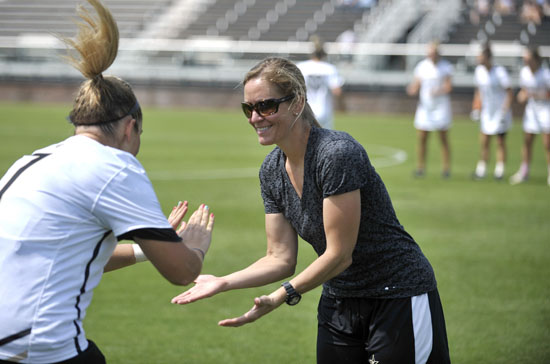June 27, 2012

Roots is a series that profiles Vanderbilt coaches, and reflects back on their lives, forming a roadmap that guides readers through the early years of their lives to where they are today.
Jeremy Organ (Swimming) | Greg Allen (Women’s Golf) | Ian Duvenhage (Men’s Tennis)
When Vanderbilt Lacrosse Coach Cathy Swezey began at Vanderbilt before the 1998 season, lacrosse was very much a niche sport with the players and teams primarily located in the Northeast. For the majority of residents in Tennessee and a good portion of the rest of the country, for that matter, the sport was very unfamiliar.
“When I first flew down here getting ready to interview,” Swezey said, “somebody on the plane said, ‘Oh you are interviewing for the lacrosse position, isn’t that like archery?’ Then somebody said, ‘No, it is like polo.’ I’ll never forget that. There really was no lacrosse in the South and they had no concept of what it was about.”
Outside of Vanderbilt’s campus, the sport of lacrosse ceased to exist in Tennessee. There were no club teams or high school teams. All of Vanderbilt’s recruiting had to be done hours away from campus, which left the Commodores’ program very much on an island compared to the competition.
A lot has changed in the world of lacrosse since 1998. Tennessee began crowning a state champion in 2002 and the sport – while still most popular in the Northeast – has grown exponentially. And large areas for growth remain very much untapped.
Despite the inherent disadvantages of coaching a sport in a region of the country where it was not commonly played, Swezey quickly guided Vanderbilt’s program to new heights. In 2002, she was named American Lacrosse Conference Coach of the Year and in 2004, she took the Commodores to the Final Four.
Swezey’s 2004 squad become the first team from outside the eastern time zone to reach the Final Four. Since the team’s historic success in 2004, other programs from outside the Northeast have risen to new levels. Florida reached the Final Four just three years into the program’s existence. Northwestern is a perennial power; winning seven of the last eight national championships. Schools such as Michigan, Southern Cal and Marquette will be adding the sport in the next few years.
 The sport is growing leaps and bounds and it was lacrosse’s tremendous opportunity for growth that was part of what hooked Swezey on the sport.
The sport is growing leaps and bounds and it was lacrosse’s tremendous opportunity for growth that was part of what hooked Swezey on the sport.
A two-sport star in Moorestown, N.J., Swezey was talented enough to play lacrosse or field hockey in college and she chose to play both at Trenton State (now College of New Jersey).
“I wanted to play both and that is one of the reasons I looked at Trenton State because I knew that was going to be an option for me,” Swezey said. “The Division I opportunities I had in lacrosse were at Penn State, William & Mary and a few others. I had a couple of field hockey opportunities, but it was not my passion, so I was not going to pursue that solely.”
Finding two-sport college athletes has become increasingly more difficult over time with each sport having specialized training and conditioning to go along with an increased number of practices. For Swezey, being a two-sport athlete in the 90s kept her busy, but it did not drastically alter her routine from high school to college.
“It definitely has changed, but the interesting thing is that that is what you are used to growing up,” Swezey said. “As a high school student-athlete you play a sport everyday. You end one season and you are starting the next. While a lot of people consider it really challenging, it really wasn’t any different than I’d already done. I loved being competitive year round and just practicing. That is probably the challenge that athletes have these days with a lot more practice and not competing in the offseason.”
In college, Swezey was good at both sports, but found more success on the lacrosse field. She was a three-time All-American and played key roles on three national championship lacrosse teams in 1991, 1992 and 1994.
Swezey was introduced to field hockey and lacrosse as a fifth grader in P.E. class. She began playing both competitively in seventh grade. “The age kids start playing now is probably the biggest difference between when I started, and when kids today start,” Swezey said. “Starting when I did would be considered really late these days. Now they start kids early and play year round.”
While she enjoyed field hockey, it was lacrosse that really moved the needle.
“I had a little bit more passion for lacrosse than field hockey,” Swezey said. “I loved hockey when I was playing it, but I loved lacrosse all the time.”
She loved lacrosse, but did not enter college with the goal of making a career out of it. Swezey began school majoring in psychology with the intention of becoming a sports psychologist. Like many college students before her and many since, those aspirations changed after her freshman year.
“I coached my first camp the summer after my freshman year and I think I was just amazed at how rewarding I felt like it was if you could get somebody to understand something and get someone to improve over a week’s period,” Swezey recalled.
For Swezey, the shift from psychology to coaching came during a four-day period.
“At camp, the team I was coaching scrimmaged an all-star team from the area the first night of the camp and they killed us,” Swezey said, “so my team was like, ‘This stinks, we don’t want to play the all-star team.’ Four days later, we played the all-star team again and beat them. I remember just feeling so rewarded for that accomplishment and I think that was the turning point for me.”
With a new career aspiration, Swezey set out to become a graduate assistant lacrosse coach. She had it arranged to become Temple’s graduate assistant after her senior year, but in February she tore her ACL.
“I wanted to complete my playing career, but I was finished educationally so my coach suggested that I start my master’s degree at Trenton State,” Swezey remarked. “She said I could be her grad assistant and help in the office. I accepted the offer and it was a very, very busy couple years of my life.”
In addition to coaching lacrosse Swezey also served as a graduate assistant on the field hockey team. But just like her playing days, she preferred coaching lacrosse more so than field hockey.
“I think even watching where the game has come now, all these years later, I just felt like there was more growth for the game,” Swezey said. “It was a more free game. You could be a lot more creative. I just felt that there was a lot more you could accomplish.”
Following her time as a graduate assistant, Swezey would catch on as an assistant lacrosse coach at James Madison University in 1996 and 1997. Two years later, she was given the opportunity to coach the Commodores.
She is now 19 years into her coaching career in a sport that has taken her places she never would have expected when she was first introduced to it as a fifth-grader in P.E. class.

What is the hardest part of lacrosse to understand for a first-time viewer?
The rules. They can be difficult to understand for someone new to the sport. Anyone can catch the speed of the game and the energy and excitement, but they are not going to understand why play stopped. They are also not going to understand why no one can move when play is stopped.
Strategically, what sports are most similar to lacrosse?
People would laugh when I say this because they would not understand the comparison, but ice hockey and basketball are similar because a lot of the play occurs right in front of the nets. Just like basketball, there is a transition game and a lot of the fouls are the same. Ice hockey is similar mostly because of the speed and the ability to play behind the net.
What do you enjoy most about going back to your hometown of Moorestown, N.J.?
I don’t get back as often as I should. But I just love being in my hometown. Moorestown is a really quaint little town. I think US News and World Report picked it as the “Best Town” to live in a few years ago. It is just a really pretty quaint town. It has a really good little downtown and the homes are all historic and beautiful victorians. It is just a pretty place to go.
Moorestown is just outside Philadelphia, for cheesesteak do you prefer Geno’s or Pat’s?
Pat’s. I’m actually not big into cheesesteaks, but I’d probably prefer Pat’s.

You can follow me on ![]() Twitter @SchulzRyan
Twitter @SchulzRyan

